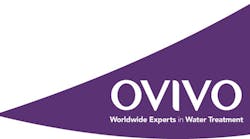Union Rome Wastewater Treatment Plant (WWTP) in Union Rome, Ohio, currently operates a membrane bioreactor (MBR) activated sludge system followed by an Ovivo pre-thickened aerobic digestion process using a Kubota P.A.D.-K flat plate membrane thickener process that was commissioned in December 2009.
Union Rome Sewer Authority contracted with CT Consultants to design a wastewater treatment facility to handle its municipal wastewater. The main objective of the Union Rome WWTP design was to minimize the footprint of the facility so that the entire operation could be constructed in one building. Minimizing the facility’s footprint provided substantial savings in building costs. Ovivo recommended the P.A.D.-K process to CT Consultants. Many traditional aerobic digestion systems rely on decanting, which can provide unreliable thickening performance, resulting in larger process tank footprints.
Membrane thickening provides reliable thickening of waste activated sludge (WAS) solids without the use of polymers and is independent of sludge settling characteristics, providing significant footprint reduction of process tanks. The solution offered the smallest footprint of all the aerobic digestion options that the Union Rome Sewer Authority considered.
The Right Choice
The Union Rome WWTP process design consists of a membrane thickening tank operating in loop with anoxic and aerobic digester tanks. Sludge at the Union Rome WWTP is thickened up to 5% solids (4.15% solids on average) with the membranes by introducing a pressure gradient created by the rising bubbles from a coarse air diffuser located on the bottom of the membrane unit. This pressure gradient induces an upward crossflow of mixed liquor over the membranes, allowing for wastewater (permeate) to be filtered from the sludge.
The aerobic digester tank was designed with Mansel Smith diffusers and shear tubes to provide maximum mixing and aeration efficiency of thickened solids. During digestion, the aerobic zones (membrane thickener and digester) provide nitrification with the anoxic basin, which therefore provides built-in time for denitrification and stabilizes the pH. This continuous nitrification and denitrification sequencing eliminates nitrate and ammonia in the permeate, which is critical for allowing the facility to comply with its ammonia effluent discharge limit of 1 mg/L and 0.3 mg/L for summer and winter operations, respectively.
Thickening Results. After implementing the new process at the Union Rome WWTP, superior thickening performance was achieved without the use of polymers. As shown in Table 1, thickening of WAS up to 5% solids was achieved, and was consistently more than triple the concentration of the influent total solids wasted from the MBR biological process.
Permeate Quality Results. Permeate produced from the new thickening process at the Union Rome facility is combined with the MBR effluent which is sent directly to disinfection. The permeate from this process contains less than 0.1 mg/L of ammonia, which is well below the facility’s effluent discharge limit.
Reduced Dewatering Operations
After the WAS is processed, the sludge is sent directly to a belt filter press for dewatering and disposal to a sanitary landfill. Prior to incorporating the new system, the Union Rome facility operated its belt press five days a week, 260 days per year. Improved thickening achieved with the new process substantially increased the capacity of the Union Rome facility, resulting in reduced belt filter press operations and decreasing the frequency of the sludge to be dewatered. This process reduces the belt filter press operations at the Union Rome WWTP to three days every two and a half months (15 days per year).
Since implementation of the new system, the Union Rome facility has increased its belt press efficiency by using 40% less polymer to dewater the same amount of solids as the previous sludge-handling process and reduces the quantity of sludge hauled to the landfill by more than 50%. This results in a savings of more than $58,000 in hauling costs and more than $3,000 in polymer costs annually.
Download: Here



